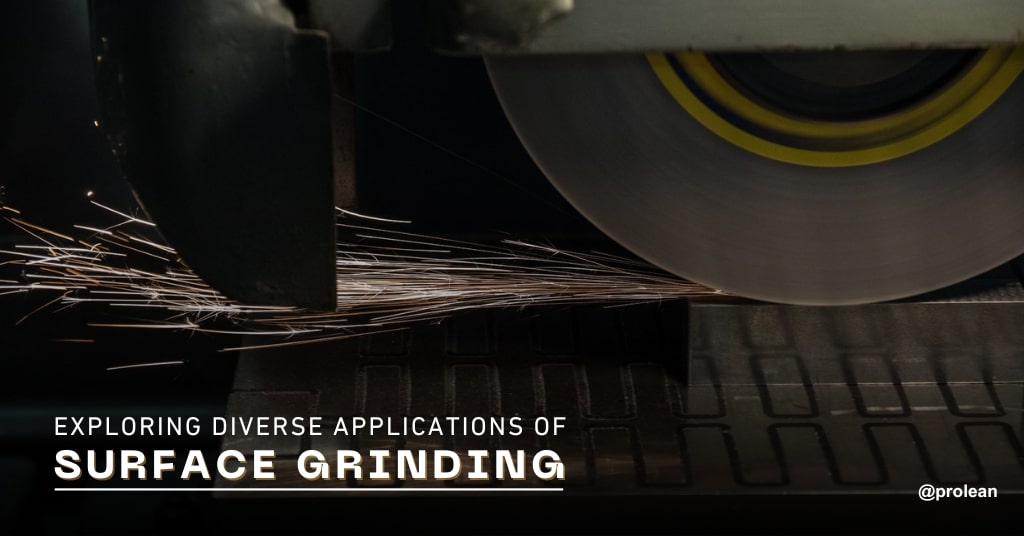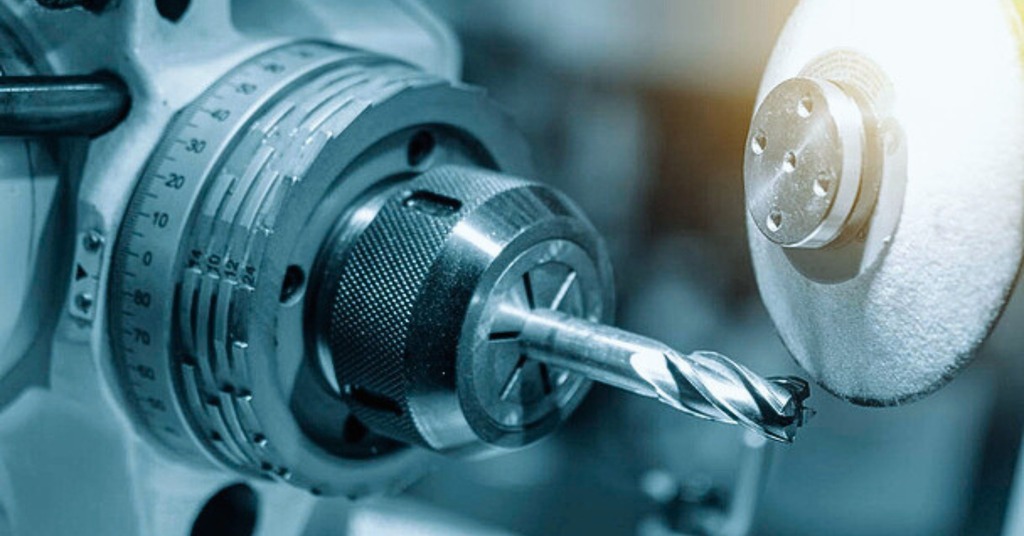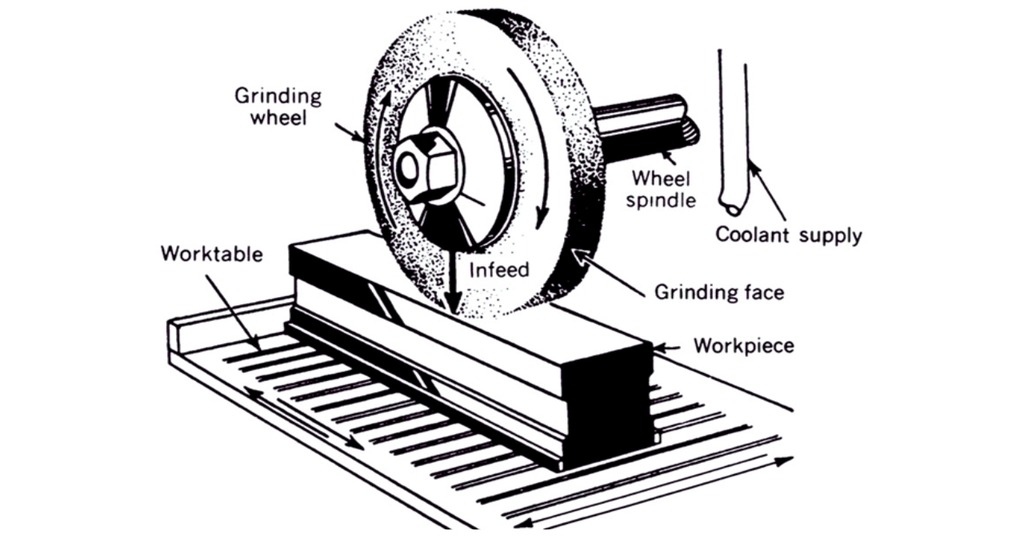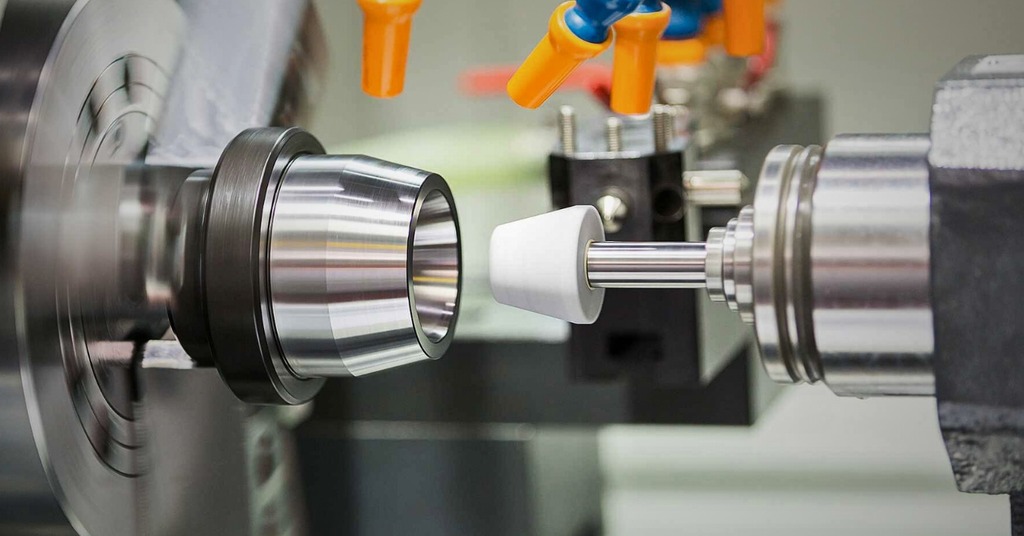“When it comes to precision, and enhancing aesthetics with functionality, and gloss, surface grinding machines play a key role. These machines help make parts stress-free without any metallurgical damage.’’

In Plastic and metalworking industries, the excessive layers of the finished material are removed with the help of surface grinders, the reason being to refine the obtained component. These machines not only enhance the functionality but also magnify the aesthetics of the workpiece and apply to a wide array of materials from metals to plastics.
The integration of CNC with conventional grinding techniques provides more command over precision grinding. While working with large production volumes, these machines are much more economical and user-friendly. That’s why grinding machines are appropriate choices for multiple sectors including railway, automotive, and aerospace.
This blog post emphasizes the enormous potential of surface grinding machines. In addition to their diversified applications, working, benefits, innovative approaches, and so more.
An Overview of Surface Grinding

Surface Grinding
In the final machining process, these machines maintain the product quality and overall effectiveness. The grit wheel and an abrasive spinning wheel clear the disproportionate material from both the metallic and non-metallic workpieces. The rotary grinding wheel comes in contact with the targeted material and peels off the undesired irregularities. More often, the rust and dirt are also removed through these machines. The basic components of surface grinding machines include;

Parts of Surface Grinding Machine
- Base
- Worktable
- Column
- Coolant supply nozzle
- Grinding wheel
- Wheel spindle
Try Prolean Now!
What is Precision Grinding?
What is Precision Grinding? As the name suggests, it involves the shaving of excessive material from the surface of the workpiece with precision. Precision grinding is also identified as cylindrical grinding. CNC integration, in this way, imparts dimensional accuracy in the finishing process. This subtractive manufacturing technique is employed for cylindrical objects, outer circles, and intricately detailed feature components.

CNC Precision Grinding
Likewise, in Diamond Milling 101, precision grinding is applicable to grind coarse materials, ceramics, plastics, glasses, and metals. Their ability to grind surfaces with small diameters up to 0.25 to 0.50 mm makes them ideal across automotive, aerospace, and medical sectors.
Moreover, these machines operate at a higher speed ranging between 1250 to 2000 m/min (Approx). Some common examples include; rotors, crankshafts, spindles, honing tools, and dies. Here are the types of precision grinding machines listed below;
Cylindrical grinding or centre-type grinding
Single & double disc grinding
Centerless grinding
Related To The Details of Accurate Grinding: A Practical Guide
1. Cylindrical Grinding
The working mechanism of cylindrical grinders is similar to lathe machines. These machines are used to delicately grind cylindrical, conical, elliptical, inside and outside dia, and plunges. Some common examples include engine components, crankshafts, bearings, automobiles, thread, and gear systems.
2. Single & Double Disc Grinding
Single & double precision grinding machines work closely to ensure perfect grind all in just one pass. As the name suggests, a single disc entails a single rotating wheel; similarly, a double disc grinding uses two opposite discs to refine the workpiece. Moreover, these machines impart high repeatability and parallelism perfection with shorter run leads.
3. Centerless Grinding
The working mechanism of centerless machines differs slightly as it uses two rotary grinding wheels to secure the workpiece without any need for spindles or fixtures. These machines can grind shafts, round bars, and rods for different grits, shapes, and sizes.
Surface Grinding Vs. Precision Grinding: Comparative Analysis
Surface grinding, and precision grinding, are used interchangeably to remove imperfections from the surface of material. They are distinct in their functionality. Let’s figure out the distinguished factors mentioned in the table below;
Table: Comparative analysis of surface grinding and precision grinding
| Aspect | Surface Grinding | Precision Grinding |
| Process | Uses a rotating abrasive wheel to remove material | Utilizes specialized tools for high-precision machining |
| Tolerance | ±0.005mm | For Dia (0.001mm to 0.005mm) For Roundness (0.001mm to 0.005mm) |
| Surface Finish | Provides a range of surface finishes depending on grit size | Offers exceptional mirror-like surface finishes |
| Applications | Ideal for flat surfaces and general grinding tasks | Suited for high-precision components with tight tolerances |
| Size and Shape | Can accommodate various workpiece sizes and shapes | Better suited for smaller, complex shapes |
Industrial Applications of Surface Grinding
Surface grinding machines are used to fulfill the needs of various sectors including; aerospace, automotive, aviation, electronics, and consumer appliances. Let’s take a closer look;
Automotive:
The CNC-based grinding machines work well on automotive parts from the engine to transmission components such as camshafts, cylinder heads, gears, and crankshafts. These machines increase the durability and workability of automotive parts.
Aerospace :
The aerospace sector depends upon CNC grinded aircraft parts like engine parts, turbine blades, housings, and compressor blades. These finished parts in turn increase the serviceability, functionality, and durability of aircraft workpieces.
Medical:
CNC surface grinding machines benefit medical sectors by fulfilling the aesthetic needs of orthopedics, dental to medical implant devices. These machines are highly capable of achieving tight dimensions and tolerances. Moreover, it is also able to sharpen edges with precision.
Here are a few examples, enlisted below; Surgical Instruments: (Scalpels, forceps, needles, and syringes)Medical Implants (Valves, connectors, pumps, and housings)Dental Tools, and catheters.
Tool & Die Making :
Precision surface grinding machines are used to shine molds, dies, cutters, and punches. The machinists rely on grinding to achieve reliability in tooling parts. As these parts are fundamental equipment for manufacturing sectors. So, they need to be perfect in every aspect in terms of shape, and size, to maintain repeatability and integrity of materials.
Electronic :
In energy sectors, surface grinding applications are impeccable. These grinding machines are maneuvered to aid aesthetic and smooth surface finish to electric components. For instance; circuit boards, capacitors, connectors, semiconductor components like microchips, and transistors. These components require inconsistent precision in shapes and sizes along with smooth and flat surfaces.
Advantages of Surface Grinding
Here are some reasons to employ surface grinding machines in your finishing projects:
- Surface grinding machines are beneficial for uniform, flattened surfaces with lower surface roughness and high mating gloss. Moreover, these machines are used to precisely shape grooves, tapers, angle cuts, and steps in materials.
- Surface grinding is economical; it requires minimum operational expertise and labor.
- Superior ability to cut glass fibers made with exact specifications.
- These machines accommodate various materials from metals to composites, such as; zircon, alumina, carbide, etc.
- Advanced grinding machines encapsulate coolant features to prevent heat generation during grinding operations.
- Moreover, it accommodates superior finishing, desired textures, and patterns at a faster rate in respective materials.
- There lies a minimum or no probability of reworking when these machines are used in grinding applications.
- It can use these as an alternative to CNC milling, and CNC Drilling.
- Grinding machines can have tighter tolerances of up to 0.2 microns and roughness of 0.1 microns.
What are the Limitations of Surface Grinding?
However, there are various benefits of surface grinding. But alongside, it carries some demerits. Product manufacturers may encounter some challenges. Let’s find out;
- These machines may require more budget for initial costs in terms of the cost of machines, grinding wheels, and toolings.
- The heat generation during grinding operation machining can pose the requirement of coolant due to friction between grinding wheels and job material.
- For large batch production runs, the process may require more time which may lead to slower machining operations.
- Particulate emission rates are slightly higher when metals and composites are in operation of grinding.
- The grinding process dictates higher noise and vibrations and ignites sparks. Therefore, it’s advisable to use personal protective equipment to soothe these issues.
- Additionally, electrical shock hazards are associated with grinding, if conductive components are not well protected.
Get On-Demand Surface Finishing at ProleanTech
Prolean plays a leading role in On-demand manufacturing applications. Here at prolean, we have the facility to accommodate in that context. Besides our custom grinding solutions, we also offer fast, high-quality, and long-lasting surface finishes from mass production to minimum order requirements all while at an affordable price within your constrained budget.
In addition to our precision perspective, we can achieve tight tolerance from a few microns to a macro level with precision and stringent quality control. Whether you need to refine intricately detailed parts to larger components, our engineer ensures the preeminence of your project with minimal turnaround.
Our finishing approach is not limited to surface grinding, besides that, we offer various finishing options to choose from. Explore your options by contacting us and get an instant free quote!
Read more:
Try Prolean Now!
Summing Up
To conclude, surface grinding has become a typical need of every metalworking industry. These machines offer dozens of benefits when it comes to dealing with tolerances and smaller dia components. High precision, accuracy, structural integrity, and refined finish are key qualities of these machines. You can say, these machines serve as the epitome of perfection by employing inch perfection.
From aerospace to automotive sectors surface grinding applications are so widespread. It enables the achievement of micro-to-milli precisions and enhances finishing features in the intended parts. Moreover, CNC integrates surface grinding innovations by automating the grinding process for optimal results. However, grinding machining through CNC requires expertise and training, because a minor error can influence the exact product specifications you are meant for. To achieve your desired specifications and results, it’s best to connect with professionals for the reliability of your intended project. They will help you reach above the level of your expectations with stringent quality standards and finishing endings.
Moreover, the information provided in this article entails critical factors to consider for a smooth and optimal grinding outcome.
FAQs
Q1.Abrasive materials used for surface grinding wheels?
Abrasive materials are mixed combinations of abrasive grains and resins. These are some commonly used abrasive materials for the surface of the grinding wheel, including;
- Cubic boron nitride
- Diamond
- Aluminum oxide
- Inconel
- Monel
- Ceramic alumina
- Zirconia alumina
- Silicon carbide
Q2. Any alternative metalworking technique to surface grinding?
Certainly, there are many other options, you can opt for depending upon specifications and dimensional standards according to your needs. Some of the commonest techniques are;
- Laser Cutting
- Waterjet Cutting
- Electric discharge Machining (EDM)
- CNC milling and turning
Q3. What are the safety precautions for surface grinding?
It’s imperative to count on safety precautions while working with grinding machines.
- Always wear PPE (safety goggles, gloves, ear plugs, face shields) for protection against debris.
- Tightly hold the workpiece for optimal grinding results to prevent deflections or deformations.
- Wait for a wheel to reach its maximum speed to prevent ineffective surface grinding.
- Frequently use coolants to control heat and prevention against malfunctioning.
- Perform the grinding process in a ventilated environment to mitigate dust issues.
Q4. On which materials precision grinding can be applied?
Surface grinding applies to metallic and nonmetallic materials. Some common metals include; cast iron, aluminum alloys, tool steels, copper, and bronze.
Q5. Which factors contribute to the premium quality of the finish?
The quality of the finish and optimum tolerance require precise control over configuration aspects, for instance;
- Grit size, shape, and wheel type used.
- The speed of the wheel
- Type of abrasive materials used
- Concisely controlled feed rates
Resources
- Peter Scallan, (2014), Grinding Machines: Principles of Modern Grinding Technology, Second Edition: Retrieved From: Science Direct
- Joes Cloudiou Lopes, (Oct 2019), Thermal Model for Surface Grinding Applications, The International Journal of Advanced ManufacturingTechnology104(5-8), DOI:10.1007/s00170-019-04101-6: Retrieved From: Research Gate




0 Comments